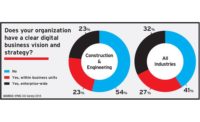Buoyed by recent project successes, industry advocates for increased application of virtual design and construction are becoming more convinced—and convincing—about VDC’s transformative potential. But hurdles persist—notably the U.S. construction industry’s lagging adoption of digital collaboration tools, as well as a looming generational workforce shift.
Industry experts and technologists spoke on the topic and presented project examples at an ENR FutureTech Conference, Dec. 11, in Atlanta.
While the use of building information modeling in the U.S. is becoming more commonplace, Steve Jones of Dodge Data & Analytics, the parent company of ENR, showed survey data demonstrating that the United Kingdom—which has mandated contractors use BIM on all public projects by 2016—and other countries are moving considerably ahead in adoption.
Noting recent research findings on BIM adoption by owners, Jones reported that two-thirds of all U.K. owners plan to require BIM on future projects, including 70% of private-sector owners. Also, according to the study, 68% of U.K. owners currently require BIM, with the U.S. rate well behind at 25%. On the positive side, however, U.S. contractors lead the world in using BIM for model-driven prefabrication, with a rate of more than 80%. According to the report, “around two thirds of both public sector (65%) and private sector (70%) UK owners say they will require BIM on new projects they will be starting, compared with less than a third (30%) of US public owners and just a handful (11%) of US private sector ones."
However, “the pace of change is changing,” says Sue Klawans, vice president with Gilbane Building Co. Promoting that “next is now,” Klawans says Gilbane, a longtime BIM user, is starting to use other rapidly improving digital tools, including laser scanning and gaming software—and hardware—to enhance current construction and design approaches. One of Gilbane’s newest additions to the digital toolbox is the Oculus Rift, a 3D gaming headset device, for instance.
John Myers, a VDC engineer with Gilbane, demonstrated how he had used the headset with Unity, a gaming visualization software, to display a navigable, 3D immersion experience to visually explore a Connecticut office-building atrium design. The atrium idea was a late-stage owner-driven design change to enclose and bridge a space between two buildings. By the time the design was complete, the actual site was heavily occluded by scaffolding and equipment for other work, making visualization of the design on site nearly impossible. By using the Oculus Rift, Meyer was able to give the project’s field staff a realistic, navigable view of the complex design.
The digital tools boost the project team’s intelligence, claims Myers. “We have a vested interest in making sure that everyone is smarter and better.”
Not all FutureTech presenters relied on anecdotal evidence to make the case for hastened VDC adoption.
Ricardo Khan, director of integrated construction with Mortenson, reported his firm’s recent research findings covering 18 of its past VDC projects.
Ranging in value from $24 million to $420 million, the projects were built over an 11-year period, ending in 2013. According to the research, Khan said the contractor reduced project schedules by an average of 32 days, and achieved "25% and greater” increases in overall productivity. The approach also reduced direct project costs by almost 3%.






